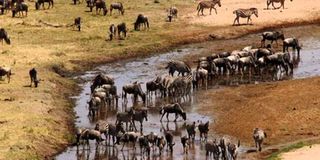Falling water levels threaten lives of animals at Tarangire National Park

What you need to know:
Existence of animals and other living organisms at Tarangire National Park depend mostly on the river, which is currently facing a challenge of reduced water levels.
Arusha. Animals at Tarangire National Park in northern Tanzania may face extinction in years to come, if necessary measures are not taken to rescue Tarangire River from drying up.
Existence of animals and other living organisms at Tarangire National Park depend mostly on the river, which is currently facing a challenge of reduced water levels.
“Water level at Tarangire River is alarmingly low and this is threatening the existence of wild animals at the National Park,” said the Tanapa director general, Mr Allan Kijazi.
The water levels, he said, have fallen dramatically due to increased human economic activities along the main source of Tarangire River at Kondoa district, Dodoma region.
“We are calling upon the parliament and the government ensure that the source of Tarangire River is protected. If this is not taken into consideration, the lives of animals will be in danger,” he said.
A warden at Tarangire National Park, Mr Helman Bitaho said water levels have not improved despite an increase in the amount of rainfall.
“If water levels go down further, animals will be forced to go out in search of the vital liquid to quench their thirst as well as pasture. This may result into some catastrophic outcomes on lives of people around the national park,” he said.
The chairman for a parliamentary committee on land, natural resources and tourism, Ms Kemilembe Luota said although some factors are generally caused by global warning, Tanapa’s concern should not be ignored.
Ms Luota said it is important for the government to revisit the importance of national parks to the economy and make sure that economic activities along the river do not interfere with the ecological system.
The deputy Minister for Natural Resources and Tourism, Mr Japhet Hasunga said protection of water resources is multi-sectoral because it involves more than one ministry, noting that it was important for the government to have one voice on the issue.
“We need to have common stand on this issue because it involves the Ministry of Natural Resources and Tourism, the Ministry of Land, Housing and Human Settlements development as well as ministries responsible for water and local governments,” he said.
He noted that the main solution for this problem was to come up with land plan for all villages surrounding national parks.



